The Different Types of Hard Drives
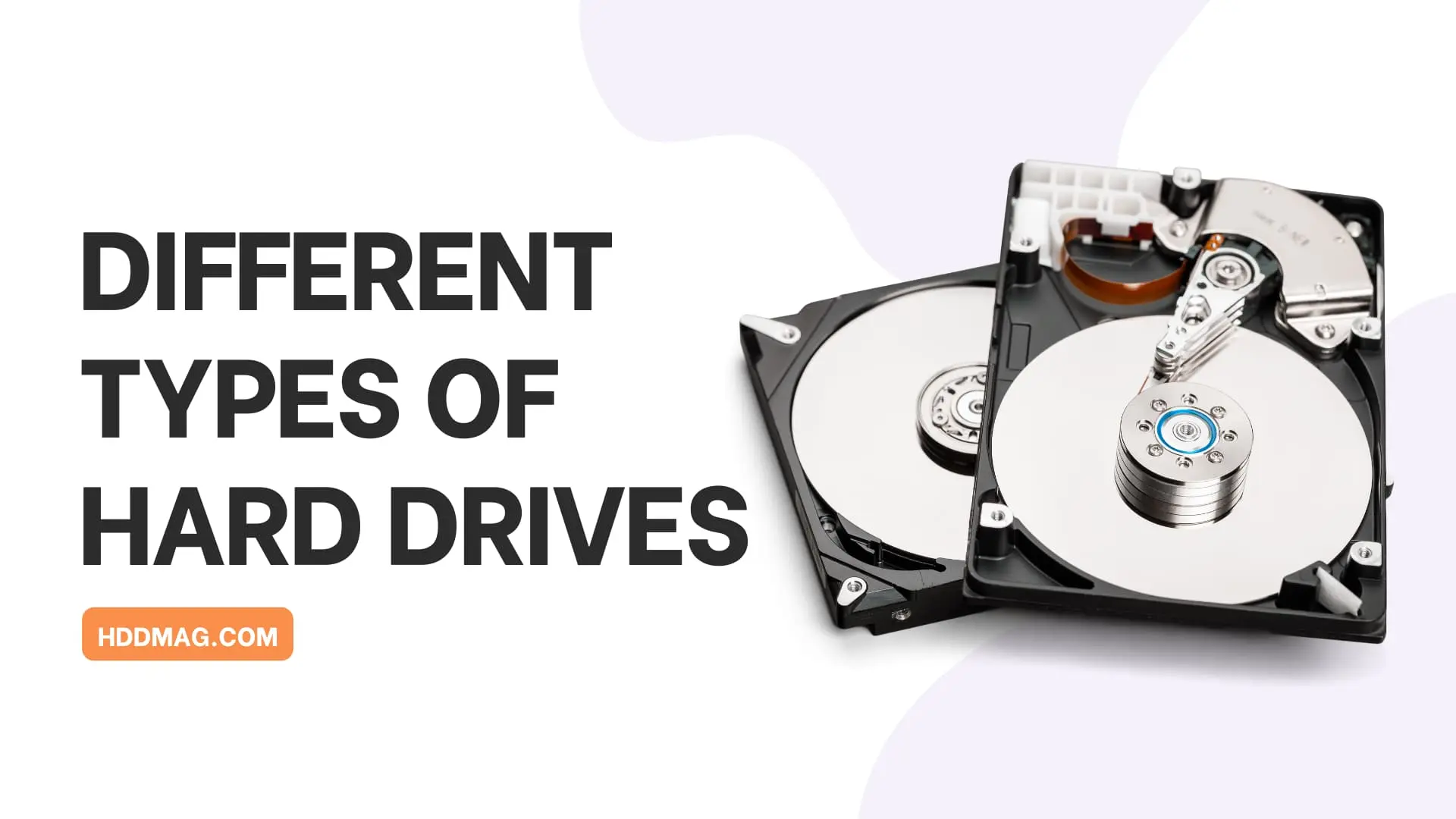
Hard drives come in many different shapes and sizes, each with its own specific purpose. Some are designed for storing large amounts of data, while others are better suited for storing application files or photos. Below is a look at the different types of hard drives and their purposes.
1. The Traditional Hard Drive

The traditional hard drive, also known as HDD (Hard Disk Drive), is a storage device that uses spinning disks to store data. The disks are coated with a magnetic material that stores data as a series of bits. When the computer wants to read or write data, it sends a signal to the hard drive that causes the disks to spin. The read head then scans across the disk and reads the bits.
a. Most Common Uses of a Traditional Hard Drive
The traditional hard drive is one of the most common ways to store data on a computer. The traditional hard drive is slower than other forms of storage, but it is more affordable and can hold more data. Hard drives are typically used in desktop and laptop computers, as well as game consoles.
b. Benefits of Using a Traditional Hard Drive
Benefits of using a traditional hard drive include:
i. Reliability: A traditional hard drive is a more reliable option than a solid state drive. They are less likely to fail, and if they do, they are easier to fix.
ii. Capacity: Hard drives can store more data than any other type of storage device.
iii. Performance: Hard drives offer faster read and write speeds than other types of storage devices.
iv. Speed: Hard drives sometimes offer faster speeds than other storage optionswithin the same price range.
v. Cost: Hard drives are affordable storage options.
c. Downsides of Using a Traditional Hard Drive
Hard drives are a staple in the computer industry, but there are some major downsides to using them. These include:
i. Limited life span: Hard drives have a limited life span and will eventually fail.
ii. Fragmentation: Hard drives become fragmented over time, which can lead to decreased performance.
iii. No backup: If your hard drive fails, you lose all your data.
iv. Susceptibility to viruses: Traditional hard drives are susceptible to viruses and other malware.
v. Noise: Hard drives are loud and can be disruptive in quiet environments.
vi. Heat: Hard drives generate a lot of heat, which can be harmful to your computer.
vii. Speed: Hard drives are slow and becoming more obsolete as time goes on.
viii. Power consumption: Traditionally, hard drives use more power than other storage options, like solid state drives. This is because hard drives need to continually spin in order to read and write data, while solid state drives only need to be powered on when data is being accessed. This can be a downside for people who are concerned about their carbon footprint or want to save on energy costs.
ix. Shock rating: Shock rating is a downside of using a HDD because it can be easily damaged if it is dropped. Additionally, the moving parts inside a HDD make it more susceptible to failure if it is bumped or jostled. The jolt can cause the read/write head to collide with the disk surface, potentially damaging the disk and causing data loss.
2. The Solid State Drive
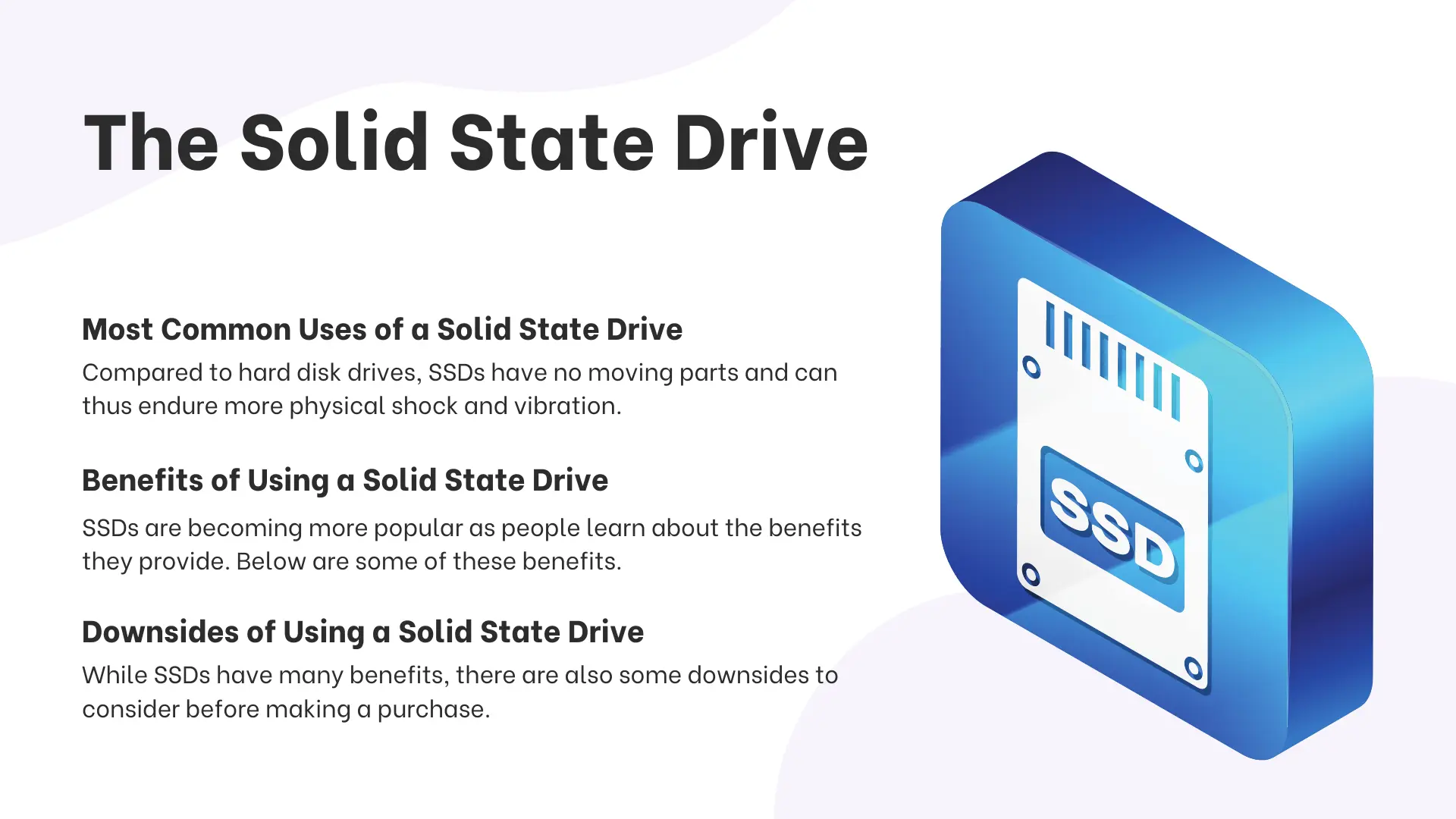
A solid state drive (SSD) is a data storage device that uses integrated circuits to store data. Compared to traditional hard drives, SSDs are faster, more reliable, and use less power. This makes them ideal for mobile devices and laptops. SSDs are available in two formats: SATA and PCIe. SATA SSDs use the same connector as traditional hard drives, while PCIe SSDs use a different connector that is not compatible with traditional hard drives.
a. Most Common Uses of a Solid State Drive
Compared to hard disk drives, SSDs have no moving parts and can thus endure more physical shock and vibration. They also consume less power, which makes them ideal for portable devices. As such, The most common use for an SSD is to replace a traditional hard disk drive in a computer. SSDs are often found being used as the primary drive in a laptop or desktop computer.
b. Benefits of Using a Solid State Drive
SSDs are becoming more popular as people learn about the benefits they provide. Below are some of these benefits.
i. Speed: SSDs are much faster than traditional hard drives. This makes them ideal for use in laptops and other portable devices.
ii. Capacity: Newer, very expensive SSDs can hold more data than traditional hard drives. This means that you can store more files on an SSD, which is especially important if you have a lot of music or video files.
iii. Durability: SSDs are much more durable than traditional hard drives. This means that they are less likely to fail, which can be important if you use your computer for important tasks.
iv. Cooling: SSDs run cooler than traditional hard drives, which can help to keep your computer running smoothly.
v. Low power consumption: The low power consumption of an SSD is an advantage because it saves energy. With a traditional hard drive, when the computer is idle, the hard drive continues to run and consumes energy. An SSD does not need to run when the computer is idle, which reduces the amount of energy used.
vi. Noise: SSDs make less noise than traditional hard drives.
vii. Reliability: SSDs have a much longer lifespan than traditional hard drives.
c. Downsides of Using a Solid State Drive
While SSDs have many benefits, there are also some downsides to consider before making a purchase. Some of these include:
i. Price: SSDs are more expensive than traditional hard drives.
ii. Capacity: Mid-range SSDs have a limited capacity compared to traditional hard drives.
iii. Speed: SSDs are much faster than traditional hard drives, but this also means that they have a shorter lifespan.
iv. No backup: If your hard drive fails, you lose all your data.
v. Fragmentation: When an SSD is filled with data, it becomes fragmented, which can lead to a decrease in performance.
vi. Reliability: SSDs are less reliable than traditional hard drives.
vii. Susceptibility to electrical shocks: Because SSDs have no moving parts, they are typically more resilient to drops and bumps, but they can also be more susceptible to damage from electrical surges.
3. The Hybrid Hard Drive

A hybrid hard drive (HHD) is a type of hard drive that combines a traditional spinning hard drive with a solid state drive. The traditional spinning hard drive stores large amounts of data, while the solid state drive delivers faster performance by using flash-memory chips. The hybrid hard drive combines the strengths of both drives, delivering fast performance and large storage capacity.
a. Most Common Uses of a Hybrid Hard Drive
As we just mentioned, hybrid drives are a combination of a regular hard drive and a small amount of flash memory. This makes them ideal for laptops where space is limited and speed is important. An example would be a gaming laptop. The flash memory can be used to store the operating system and frequently used games, which makes the computer start up faster and run more smoothly. The regular hard drive can be used to store larger files, such as gaming files, music, and video files.
b. Benefits of Using a Hybrid Hard Drive
For these reasons mentioned below, HHDs are becoming increasingly popular among computer users.
i. Speed: A hybrid hard drive can speed up your computer because it stores frequently used files on the faster solid state drive.
ii. Capacity: A hybrid hard drive also has a larger capacity than a regular solid state drive because it combines both technologies.
iii. Durability: A hybrid hard drive is more durable than a regular solid state drive because it has a spinning disk.
iv. Cost: A hybrid hard drive is less expensive than a regular solid state drive.
v. Longer battery life: The use of a hybrid hard drive can provide a longer battery life due to the fact that the drive can use less power to run. This is because the drive uses a small amount of flash memory to store commonly used files and programs, which allows the computer to access these files more quickly. This reduces the amount of power that is needed to run the computer, which in turn extends the battery life.
c. Downsides of Using a Hybrid Hard Drive
As with all things, using a hybrid drive also has a few disadvantages. We have listed them below.
i. Speed: Slower than traditional SSDs. Because the cache is part of the traditional hard drive, hybrid drives may not be as fast as purely solid-state drives.
ii. Capacity: Lower capacity than traditional hard drives.
iii. Price: More expensive than traditional hard drives.
iv. Reliability: Prone to failure.
v. No backup: If your hard drive fails, you lose all your data.
4. The External Hard Drive

An external hard drive is a device that is used to store large amounts of data outside of the computer. This can be helpful for people who need to back up their data or for people who need more storage space than what is available on their computer. External hard drives come in a variety of sizes, and some even have the ability to connect to the computer wirelessly. External hard drives are a great way to back up your computer’s files and they also make it easy to transfer files from one computer to another.
a. Most Common Uses of an External Hard Drive
External hard drives are used for a variety of purposes, the most common of which are data backup and storage, as well as file sharing between multiple PCs. They can be used to store large files that would otherwise take up too much space on a computer’s internal drive, and they can also be used to create backups of important files in case of accidental deletion or data loss. Additionally, external hard drives can be used to transfer files between different types of devices, such as computers and smartphones. In this way, external hard drives prove helpful for users who want to access their data on multiple devices.
b. Benefits of Using an External Hard Drive
There are many benefits to using an external hard drive. Some of the most important benefits are outlined below.
i. Portability: One of the biggest benefits of using an external hard drive is its portability. This allows you to take your files with you wherever you go.
ii. Storage Capacity: Another benefit of using an external hard drive is its large storage capacity. This allows you to store more files than you would be able to on a standard USB flash drive.
iii. Backup: An external hard drive can also be used as a backup for your computer’s files. This can help ensure that your files are safe in the event of a computer crash or theft.
iv. Sharing: External hard drives can be used to share files with other people.
v. Organizing: External hard drives can help you organize your files.
vi. Saving Money: External hard drives can save you money by providing extra storage space.
c. Downsides of Using an External Hard Drive
While external hard drives have many benefits, there are also a few downsides to using them. It is important to weigh the pros and cons before making a decision on whether or not to purchase one. These cons have been listed below.
i. Speed: External hard drives are often slower than internal hard drives.
ii. Portability: External hard drives are not as portable as other storage options.
iii. Backup Frequency: You may need to backup your data more often if it is stored on an external hard drive.
iv. Easily misplaced or stolen: One potential downside of using an external hard drive is that it can be easily misplaced or stolen. This is especially true if the drive is not kept in a secure place, such as a locked drawer or safe.
v. Prone to data loss: This can be due to a number of factors, such as hardware failure, file corruption, or malware infection. If your external hard drive becomes corrupted or fails, you may lose all of your data. Additionally, if your computer is infected with malware, it can spread to your external hard drive and damage your files.
vi. Takes up extra space on your desk or home: Extra space is needed on your desk or home to accommodate the external hard drive. Additionally, because external hard drives rely on a power supply, they also require an outlet to function, taking up even more space and limiting where you can use them.
vii. May fall more often: Since it is compact, it may fall more often. If the data on the external hard drive is not backed up, it can be lost permanently.
5. The Network Attached Storage
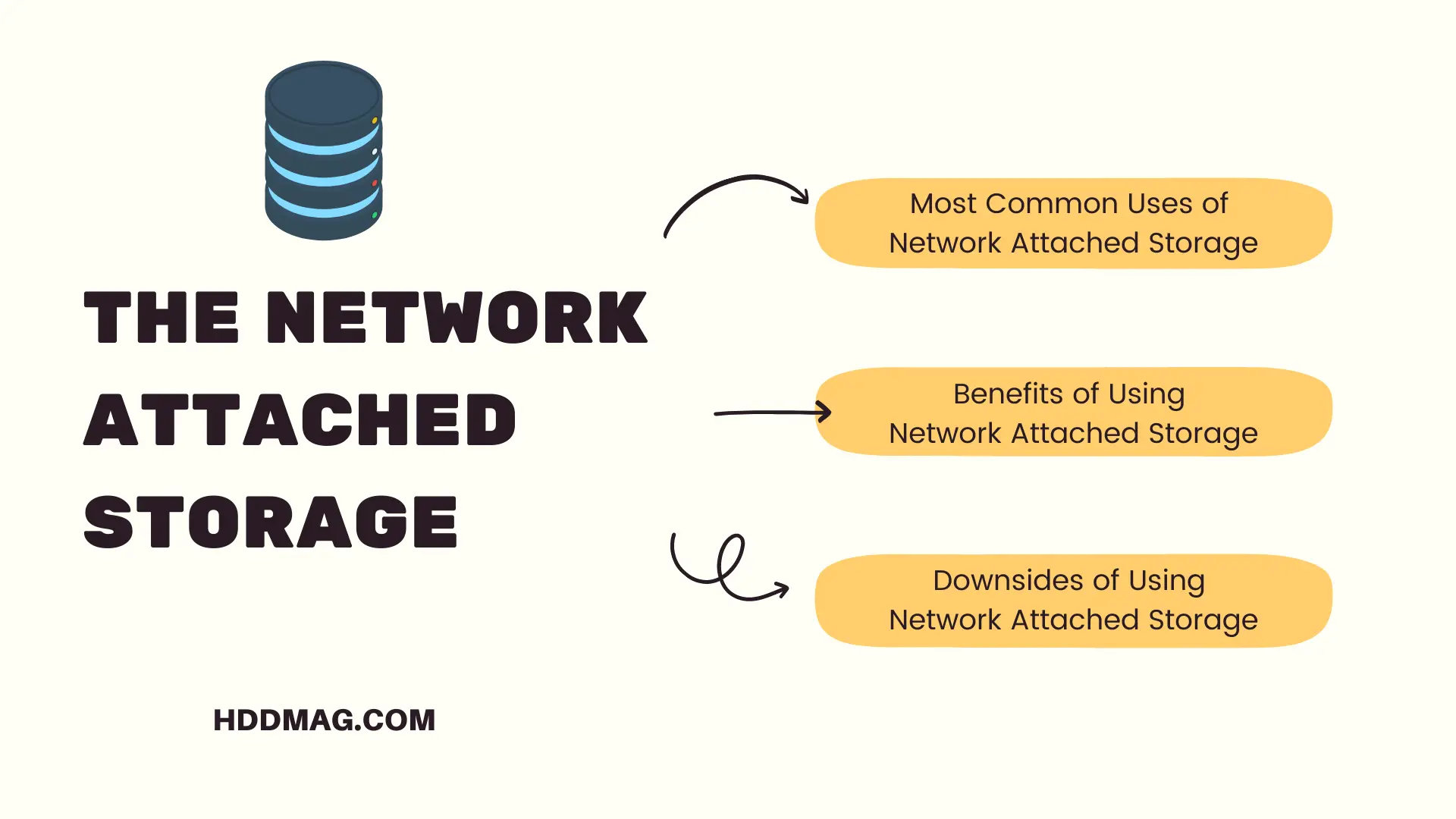
Network-attached storage (NAS) is a computer storage technology that enables users to connect their computers to a centralized storage device or server on a network. This allows users to store and share files, folders, and other data across the network. NAS devices are often used in businesses and schools to provide shared access to files and folders. Some NAS devices also include features such as printers, scanners, and photocopiers that can be shared by multiple users on the network. NAS devices come in a variety of shapes and sizes, with some offering just a few terabytes of storage, while others offer hundreds of terabytes.
a. Most Common Uses of Network Attached Storage
This type of storage is often used in businesses to store files that are shared among employees, or to backup data. Network attached storage can also be used to store music, movies, or photos that can be accessed by any device on the network. For example, it may be used to stream movies and music to different devices in the home or office. This allows users to access their multimedia content from any computer or mobile device on the network.
b. Benefits of Using Network Attached Storage
The key benefits of utilizing network connected storage are summarized in the following sections.
i. More Storage Space: One of the benefits of using NAS is that it provides users with more storage space than they would have if they were to store the files on their individual computers. This is because the files are stored on a central server, rather than on each individual computer.
ii. Flawless Collaboration: With NAS, all users on the network always have up-to-date access to the same files and folders.
iii. Private Cloud Storage: This allows for seamless collaboration between users, as any file saved to the NAS will be accessible from any device on the network without th indeed of a USB, for example.
iv. Automated Data Backup: NAS devices typically come with their own software that allows for easy automatic file backups.
v. Data Protection: They are also often equipped with RAID technology, which protects your data in case of a hard drive failure.
vi. Increased security: With network attached storage, individuals and businesses can store their data in a centralized location that is accessible by authorized users only. This can help to protect the data from unauthorized access or theft. Network attached storage devices are also protected from fires, floods, and other disasters that could damage or destroy files, so have the highest levels of security.
c. Downsides of Using Network Attached Storage
Network attached storage is a great way to store data, but it has some downsides.
i. Security: If you don’t lock down your NAS, anyone on your network can access your data.
ii. Reliability: A basic NAS hass a single point of failure. If it goes down, you lose your data.
iii. Cost: A NAS can be expensive, especially if you need a lot of storage.
iv. Complexity: A NAS is not a plug-and-play device. It takes time and effort to set up and maintain.
v. Limited Functionality: Most NAS types can do only basic things like store files and backup data.
vi. Performance depends on the protocol: For example, if a network attached storage device uses a legacy protocol like Novell Netware, it can limit performance because that protocol is not as efficient as newer protocols like TCP/IP.
vii. Increased LAN traffic: This is because the NAS device often has to communicate with all of the other devices on the network in order to provide them with access to the stored files. If multiple people are trying to access the same files on the NAS at the same time, it can cause performance issues.
6. Cloud Storage
Cloud storage is a technology that allows users to store files in a remote location, accessed through the internet. This can be done through a web browser, or through an app on a mobile device. Cloud storage services are typically subscription-based, and allow users to store an unlimited amount of data for a monthly fee like Google cloud or iCloud. The files are stored on servers owned by the cloud storage provider, and can be accessed from anywhere in the world with an internet connection.
a. Most Common Uses of Cloud Storage
Cloud storage is a model for providing digital content and services over the Internet. It is an on-demand, pay-as-you-go model in which users can use a web browser, mobile app, or desktop app to access stored data. Cloud storage can be used for a variety of purposes, including backup and disaster recovery, file sharing and collaboration, content management, and software as a service (SaaS).
b. Benefits of Using Cloud Storage
Cloud storage offers many benefits over traditional storage methods. These benefits are listed below.
i. Cost: Cloud storage is often much cheaper than traditional storage solutions.
ii. Convenience: Cloud storage is incredibly convenient, allowing users to access their files from anywhere in the world.
iii. Speed: Cloud storage is much faster than traditional storage solutions.
iv. Security: Cloud storage is typically much more secure than traditional storage solutions.
v. Reliability: Cloud storage is incredibly reliable, meaning that users can count on having access to their files at all times.
vi. Automated back-ups: Cloud storage services often offer built-in backup and disaster recovery features, which can help protect users’ data in the event of a system crash or natural disaster.
vii. Scalability: By offloading storage management responsibilities to a cloud provider, organizations can improve their overall storage efficiency and maximize their return on investment in storage infrastructure.
viii. Rapid elasticity: The elasticity of the cloud allows for businesses to quickly adapt to changes in their storage needs. For example, if a business experiences a sudden increase in the number of files that need to be stored, the cloud can quickly accommodate that change. This elasticity helps businesses avoid the need for expensive and time-consuming hardware upgrades. Additionally, it enables businesses to pay only for the storage they actually use, which can save them money.
ix. Broad device access: Users can store and retrieve data from any device with internet access.
c. Downsides of Using Cloud Storage
Overall, the pros of cloud storage outweigh the cons, but it’s important to be aware of the downsides before making a decision. They are listed below.
i. Bandwidth: Cloud storage can use up a lot of bandwidth, which may not be an issue for some people but could be for others.
ii. Privacy: Your data may not be as private as you might think.
iii. Cost: Cloud storage can be expensive if you don’t watch your usage.
iv. Speed: Cloud storage can be slow when compared to local storage.
v. Reliability: Cloud storage can be unreliable at times.
7. CDs and DVDs
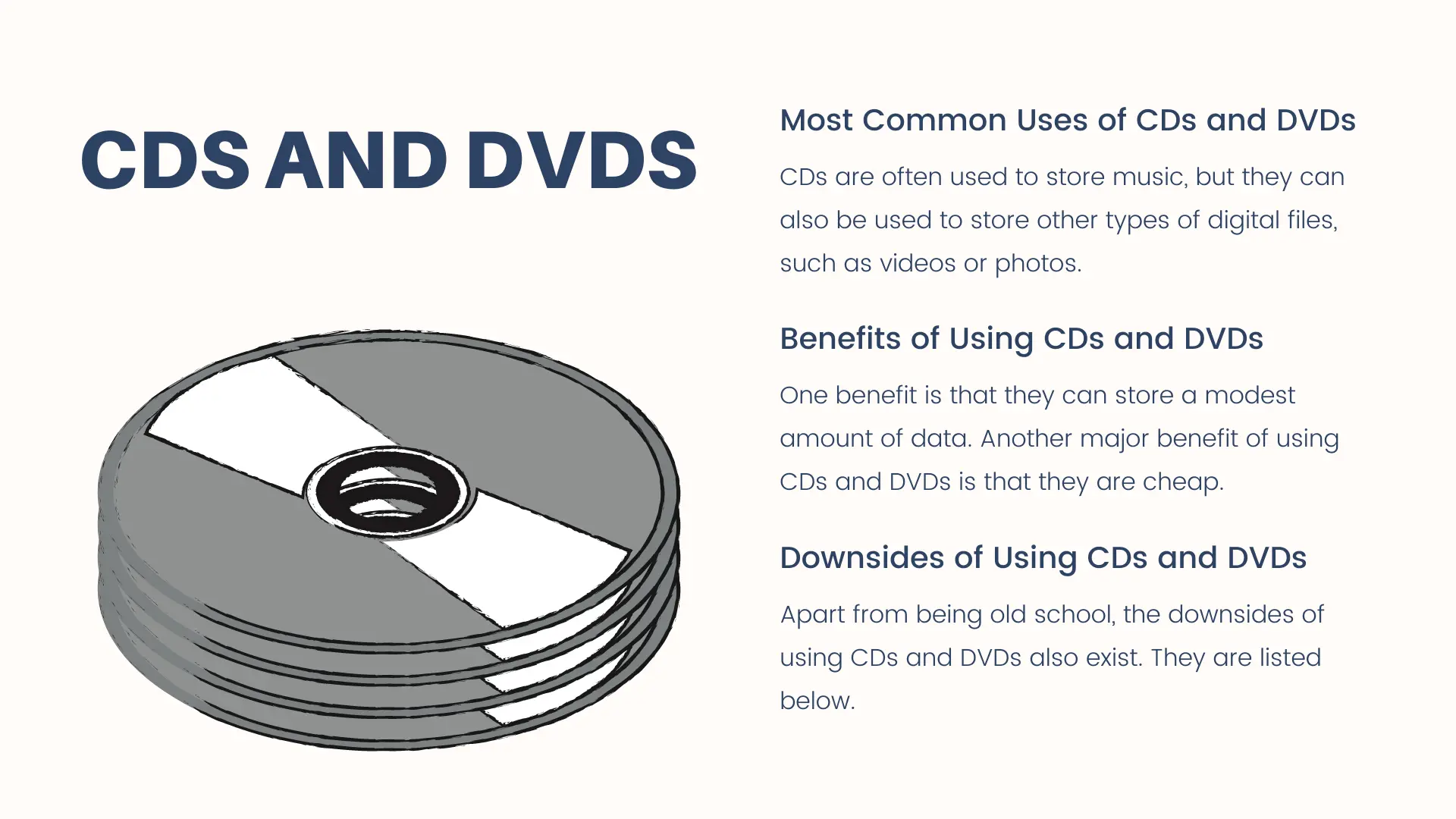
CDs and DVDs are optical storage media that use laser technology to store data. CDs can store up to 700MB of data, while DVDs can store up to 4.7GB. CDs and DVDs are used for storing music, movies, and other data.
a. Most Common Uses of CDs and DVDs
A CD, or compact disc, is a storage device that can hold a large amount of digital information. CDs are often used to store music, but they can also be used to store other types of digital files, such as videos or photos. A DVD, or digital video disc, is a type of CD that is specifically designed to store video files. DVDs can hold much more data than CDs, so they are often used to store movies or television shows.
b. Benefits of Using CDs and DVDs
There are many benefits to using CDs and DVDs.
i. Enough capacity for small files: One benefit is that they can store a modest amount of data. ii. Cheap: Another major benefit of using CDs and DVDs is that they are cheap. This makes them easy to share with others, whether you are giving them away or loaning them out.
iii. Easy to use: They are easy to use, since all you have to do is insert them into your computer or DVD player and press play.
iv. Ideal for older people: CDs and DVDs are old technology. This makes them ideal for people who are not familiar with new technology.
v. Durable: They are durable and can last for many years when properly kept and cared for.
c. Downsides of Using CDs and DVDs
Apart from being old school, the downsides of using CDs and DVDs also exist. They are listed below.
i. Requires special handling: One downside of using CDs and DVDs is that they can be easily scratched or damaged, which can affect their playback quality. If not handled or kept properly, the data on the disk may be corrupted or lost irretrievably.
ii. Physical space: They can take up a lot of physical space, which may not be ideal if someone is trying to save space.
iii. Storage space: CDs and DVDs can only store a limited amount of data, so they are not ideal for storing large files.
iv. Cannot be easily shared: This is because they need to be physically passed around in order to be used, which can be difficult if there are a lot of people trying to use them at the same time.
v. Cannot be played on several devices: A downside to using CDs and DVDs is that they cannot be played on several newer PCs. This can be a problem for users who want to access CDs and DVDs on newer devices.
Conclusion
In conclusion, there are many different types of hard drives on the market. It is important to know the differences between them so that you can find the right one for your needs. We hope we have been able to help with that.
In summary, and in our professional opinion though, if you are looking for a fast, reliable drive, then you should consider a solid state drive. If you need a lot of storage space, then a traditional hard drive may be a better option. In any case, whichever type of hard drive you choose, be sure to back up your data regularly to an external hard drive or to a cloud service provider to protect it from loss or damage.

![Top 6 Fastest External Hard Drives for Xbox One [2018]](https://hddmag.com/wp-content/uploads/2017/05/fastest-xbox-one-external-hard-drive-768x512.jpg)
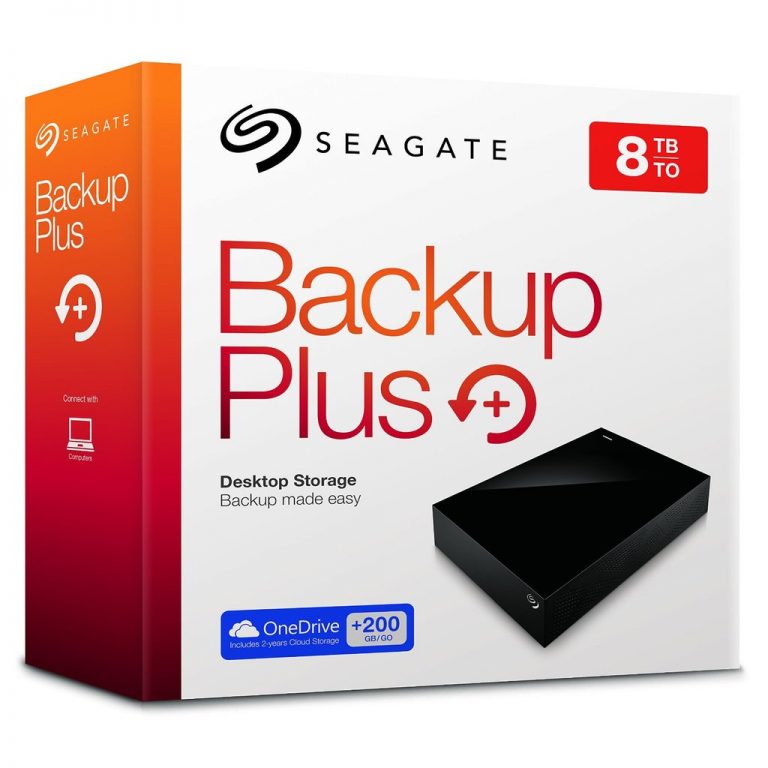


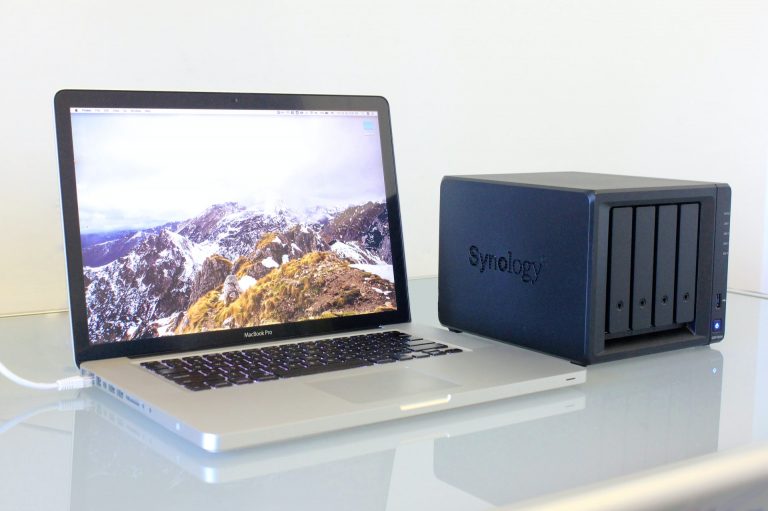
![Crucial MX300 SSD Review [2022]](https://hddmag.com/wp-content/uploads/2017/10/Crucial-MX300-SSD-featured-768x574.png)